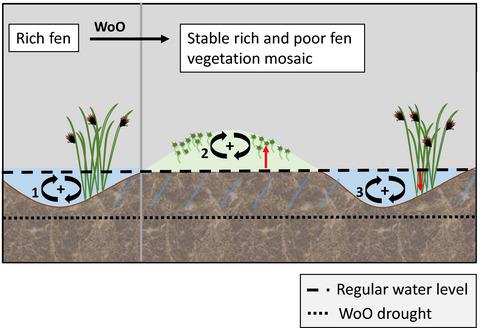当前位置:
X-MOL 学术
›
Journal of Vegetation Science
›
论文详情
Our official English website, www.x-mol.net, welcomes your
feedback! (Note: you will need to create a separate account there.)
Self‐facilitation and negative species interactions could drive microscale vegetation mosaic in a floating fen
Journal of Vegetation Science ( IF 2.2 ) Pub Date : 2020-02-27 , DOI: 10.1111/jvs.12851 Tamara J. H. M. Bergen 1, 2 , Ralph J. M. Temmink 1 , Loekie Tweel‐Groot 1 , Wiene J. Bakker 1 , Katrin Rehlmeyer 1 , Adam H. W. Koks 1, 3 , Annemiek C. Waajen 1, 4 , Jan G. M. Roelofs 3 , Albert P. Grootjans 1, 5 , Tjisse Heide 1, 6, 7 , Leon P. M. Lamers 1, 3
Journal of Vegetation Science ( IF 2.2 ) Pub Date : 2020-02-27 , DOI: 10.1111/jvs.12851 Tamara J. H. M. Bergen 1, 2 , Ralph J. M. Temmink 1 , Loekie Tweel‐Groot 1 , Wiene J. Bakker 1 , Katrin Rehlmeyer 1 , Adam H. W. Koks 1, 3 , Annemiek C. Waajen 1, 4 , Jan G. M. Roelofs 3 , Albert P. Grootjans 1, 5 , Tjisse Heide 1, 6, 7 , Leon P. M. Lamers 1, 3
Affiliation

|
Aim: The formation of a local vegetation mosaic may be attributed to local variation in abiotic environmental conditions. Recent research, however, indicates that self-facilitating organisms and negative species interactions may be a driving factor. In this study, we explore whether heterogeneous geohydrological conditions or vegetation feedbacks and interactions could be responsible for a vegetation mosaic of rich and poor fen species. Location: Lake Aturtaun, Roundstone Bog, Ireland. Methods: In a floating fen, transects were set out to analyze the relation between vegetation type and rock–peat distance and porewater electrical conductivity. Furthermore, three distinct vegetation types were studied: rich fen, poor fen and patches of poor fen within rich fen vegetation. Biogeochemical measurements were conducted in a vertical profile to distinguish abiotic conditions of distinct vegetation types. Results: Geohydrological conditions may drive the distribution of poor and rich fen species at a larger scale in the floating fen, due to the supply of minerotrophic groundwater. Interestingly, both rich and poor fen vegetation occurred in a mosaic, when electrical conductivity values at 50 cm depth were between 300 µS/cm and 450 µS/cm. Although environmental conditions were homogeneous at 50 cm, they differed markedly between rich and poor fen vegetation at 10 cm depth. Specifically, our measurements indicate that poor fen vegetation lowered porewater alkalinity, bicarbonate concentrations and pH. No effects of rich fen vegetation at 10 cm depth on biogeochemistry was measured. However, rich fen litter had a higher mineralization rate than poor fen litter, which increases the influence of minerotrophic water in rich fen habitat. Conclusions: These results strengthen our hypothesis that species can drive formation of vegetation mosaics under environmentally homogeneous conditions in a floating fen. Positive intraspecific self-facilitating mechanisms and negative species interactions could be responsible for a stable coexistence of species, even leading to local ecosystem engineering by the species, explaining the local vegetation mosaic at the microscale level in a floating fen.
中文翻译:

自我促进和负面物种相互作用可以驱动浮沼中的微尺度植被镶嵌
目的:局部植被镶嵌的形成可能归因于非生物环境条件的局部变化。然而,最近的研究表明,自我促进的生物体和消极的物种相互作用可能是一个驱动因素。在这项研究中,我们探索了异质的地质水文条件或植被反馈和相互作用是否可能导致丰富和贫乏的蕨类植物的植被镶嵌。地点:爱尔兰圆石沼泽的阿图尔坦湖。方法:在漂浮的沼泽中,设置横断面以分析植被类型与岩-泥炭距离和孔隙水电导率之间的关系。此外,研究了三种不同的植被类型:富沼、贫沼和富沼植被中的贫沼斑块。生物地球化学测量是在垂直剖面上进行的,以区分不同植被类型的非生物条件。结果:由于矿质营养地下水的供应,地质水文条件可能会在更大范围内驱动贫沼和富沼物种在漂浮沼泽中的分布。有趣的是,当 50 cm 深度处的电导率值介于 300 µS/cm 和 450 µS/cm 之间时,丰富和贫瘠的沼泽植被都出现在马赛克中。虽然环境条件在 50 cm 处是均质的,但在 10 cm 深度处,它们在肥沃植被和贫瘠植被之间存在显着差异。具体而言,我们的测量表明,贫瘠的沼泽植被降低了孔隙水的碱度、碳酸氢盐浓度和 pH 值。没有测量到 10 厘米深度处丰富的沼泽植被对生物地球化学的影响。然而,富沼生境的矿化率高于贫沼,增加了富沼生境矿质营养水的影响。结论:这些结果加强了我们的假设,即物种可以在漂浮的环境均匀条件下推动植被马赛克的形成。积极的种内自我促进机制和消极的物种相互作用可能是物种稳定共存的原因,甚至导致物种的当地生态系统工程,解释了漂浮沼泽中微观尺度的当地植被镶嵌。这些结果加强了我们的假设,即物种可以在漂浮的环境均匀条件下推动植被马赛克的形成。积极的种内自我促进机制和消极的物种相互作用可能是物种稳定共存的原因,甚至导致物种的当地生态系统工程,解释了漂浮沼泽中微观尺度的当地植被镶嵌。这些结果加强了我们的假设,即物种可以在漂浮的环境均匀条件下推动植被马赛克的形成。积极的种内自我促进机制和消极的物种相互作用可能是物种稳定共存的原因,甚至导致物种的当地生态系统工程,解释了漂浮沼泽中微观尺度的当地植被镶嵌。
更新日期:2020-02-27
中文翻译:

自我促进和负面物种相互作用可以驱动浮沼中的微尺度植被镶嵌
目的:局部植被镶嵌的形成可能归因于非生物环境条件的局部变化。然而,最近的研究表明,自我促进的生物体和消极的物种相互作用可能是一个驱动因素。在这项研究中,我们探索了异质的地质水文条件或植被反馈和相互作用是否可能导致丰富和贫乏的蕨类植物的植被镶嵌。地点:爱尔兰圆石沼泽的阿图尔坦湖。方法:在漂浮的沼泽中,设置横断面以分析植被类型与岩-泥炭距离和孔隙水电导率之间的关系。此外,研究了三种不同的植被类型:富沼、贫沼和富沼植被中的贫沼斑块。生物地球化学测量是在垂直剖面上进行的,以区分不同植被类型的非生物条件。结果:由于矿质营养地下水的供应,地质水文条件可能会在更大范围内驱动贫沼和富沼物种在漂浮沼泽中的分布。有趣的是,当 50 cm 深度处的电导率值介于 300 µS/cm 和 450 µS/cm 之间时,丰富和贫瘠的沼泽植被都出现在马赛克中。虽然环境条件在 50 cm 处是均质的,但在 10 cm 深度处,它们在肥沃植被和贫瘠植被之间存在显着差异。具体而言,我们的测量表明,贫瘠的沼泽植被降低了孔隙水的碱度、碳酸氢盐浓度和 pH 值。没有测量到 10 厘米深度处丰富的沼泽植被对生物地球化学的影响。然而,富沼生境的矿化率高于贫沼,增加了富沼生境矿质营养水的影响。结论:这些结果加强了我们的假设,即物种可以在漂浮的环境均匀条件下推动植被马赛克的形成。积极的种内自我促进机制和消极的物种相互作用可能是物种稳定共存的原因,甚至导致物种的当地生态系统工程,解释了漂浮沼泽中微观尺度的当地植被镶嵌。这些结果加强了我们的假设,即物种可以在漂浮的环境均匀条件下推动植被马赛克的形成。积极的种内自我促进机制和消极的物种相互作用可能是物种稳定共存的原因,甚至导致物种的当地生态系统工程,解释了漂浮沼泽中微观尺度的当地植被镶嵌。这些结果加强了我们的假设,即物种可以在漂浮的环境均匀条件下推动植被马赛克的形成。积极的种内自我促进机制和消极的物种相互作用可能是物种稳定共存的原因,甚至导致物种的当地生态系统工程,解释了漂浮沼泽中微观尺度的当地植被镶嵌。











































 京公网安备 11010802027423号
京公网安备 11010802027423号